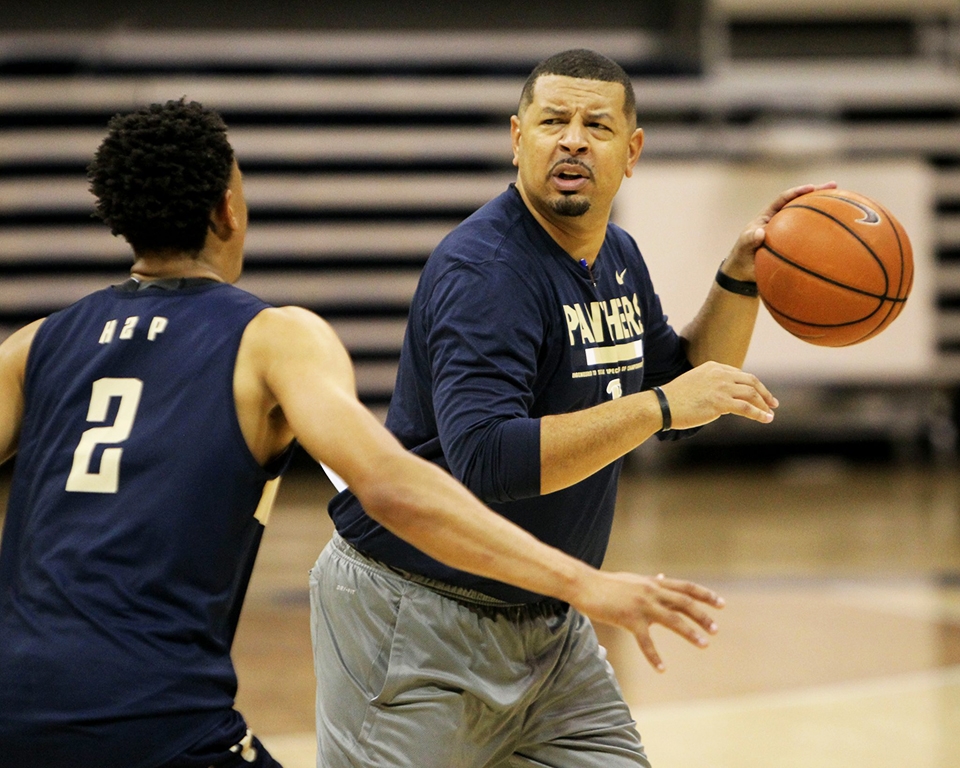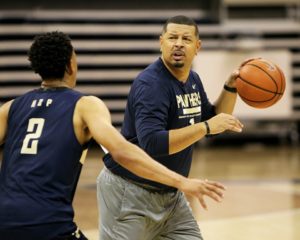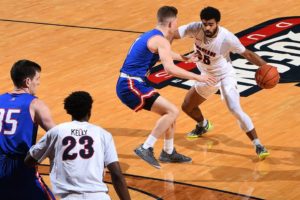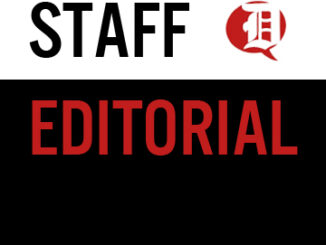

Jacob Hebda | Staff Writer
Nov. 29, 2018
Following the close of the 2017-18 college basketball season, Duquesne and Pitt were heading in very different directions.
The Dukes had wrapped up a season that, despite ending with a 1-7 stretch from February on, was surprisingly inspiring.
Duquesne was once an elite program, but that was back in the 1960s. The Dukes have not qualified for the NCAA Tournament since 1977.
The program has had some encouraging spurts here and there, but the past few decades could be broadly defined as mediocre. However, new Head Coach Keith Dambrot was able to generate excitement and momentum during his first season on the Bluff. Now, for the first time in recent years, the Dukes have genuine reason to be feeling optimistic.
The Pitt Panthers, meanwhile, appeared to be entrenched in the beginning stages of a long rebuild. Head Coach Kevin Stallings had failed to produce much of anything since his hiring in 2016, and the team was sitting firmly in the cellar of not merely the Atlantic Coast Conference, but all of college basketball at large.
Making the dilemma all the more shocking was the fact that a few years earlier, Pitt was still a steady guest in the NCAA Tournament. From 2002 to 2011, the Panthers qualified for every tourney. This stretch also included two No. 1 seedings.
It was a striking turn of events for both schools. Duquesne, long a rather inconspicuous figure in the scope of college basketball, was on the figurative upswing. Pitt, a Big East powerhouse through the greater part of the 2000s, was utterly listless.
To put this situation in perspective: one fan base was enthused by a 16-16 record, while one was shattered following just its second losing season of this century. One was excited about the prospect of making the NCAA Tournament soon, while one was struggling to cope with the reality that it would likely be a long time before they would return to the tourney — something that had once been a regularity.
That should give a better idea of how dissimilar these two programs are historically.
I penned a column back in March detailing these circumstances — the improvement of Duquesne and decline of Pitt. I intertwined the piece with A Tale of Two Cities, the classic Charles Dickens novel. It made sense at the time, but oh, how things have changed.
Now, here we are, mere months removed from that column, and both teams are suddenly on the rise.
Since the conclusion of the 2017-18 college basketball season, the Duquesne men’s team has only further proven why the hype surrounding this squad is warranted.
Dambrot is in year two on the Bluff, but he has already shifted the course of the Duquesne men’s basketball entirely.
Much like the hardship Pitt experienced this past season, the Dukes’ future looked bleak after canning former coach Jim Ferry in March 2017.
However, with Dambrot at the helm, there is a sense of energy about basketball on campus that has not been present in quite a long time.
The 2017-18 Dukes produced only the program’s second .500 record since 2012.
This year, despite significant roster turnover, returning stars Eric Williams Jr. and Mike Lewis II lead a group with little experience, but plenty of potential.
Dambrot’s four incoming transfers — Tavian Dunn-Martin, Frankie Hughes, Michael Hughes and Marcus Weathers — have been instrumental in a 4-1 record so far.
A promising class of freshmen has only augmented expectations, with some impressive showings early on.
Freshman point guard Sincere Carry has nearly half of the team’s assists (33) through five games. In his first game in a Duquesne uniform, first-year big man Austin Rotroff posted 17 points and went 3-3 from behind the three-point line. Lamar Norman Jr. was 4-4 from the field and made some clutch shots late in a comeback win against UIC.
Fellow freshmen Amari Kelly, Brandon Wade and Gavin Bizeau have had limited minutes, but they’ve flashed their potential when they’ve played.
Lewis is off to a bit of a slow start, but Williams has continued to shine as the sophomore swingman leads the Dukes in scoring and rebounding.
All of this is to say that Duquesne fans should feel confident in the future, as this roster is loaded with young talent. Lewis is actually the only upperclassman to take to the floor so far this season.
While there will be inevitable ebbs and flows for such an inexperienced collection of players, it is obvious that the buzz around the team is justified. Duquesne’s depth chart is full of promise, which is why so many are looking forward to what is yet to come.
It also doesn’t hurt to have Dambrot, with nearly 20 years of coaching experience and a career .645 winning percentage at the college level, leading the way.
Add in the impending $45 million renovation of A.J. Palumbo Center, soon to be the UPMC Chuck Cooper Fieldhouse, and there are even more reasons to be encouraged by the future of Duquesne men’s basketball.
So, not too much has changed for Duquesne since the end of last season. The Dukes have continued to build on their momentum, fulfilling expectations thus far.
However, whereas Duquesne has not strayed from its projected path, nearly everything has shifted for Pitt. The Panthers have responded shockingly well to a number of critical questions about their outlook.
Following a winless campaign in ACC play, Pitt fired Stallings in early March.
Stallings was only in Oakland for two years, but in that short time, the Panthers encountered some historic lows.
Stallings began his tenure with an underwhelming 16-17 record. In year two, though, it turned ugly. The Panthers finished 8-24 overall and 0-18 in the ACC.
In the latter season, the average attendance at the Petersen Events Center, which seats 12,508 people, was 4,117. That’s its lowest mark since 1982.
With all this considered, there was practically no reason for hope in Oakland. Thanks to such poor play on the court and attendance woes, Stallings was understandably on the hot seat. With four conference wins in two years and a dearth of talent on the roster, many figured his time in Pittsburgh might be short-lived.
Stallings was indeed fired shortly after the season ended. His struggles were clear, but there was still controversy surrounding the decision. Some believed Stallings needed more time to develop, while others claimed a coach with such an abysmal record simply could not be retained.
Compounding this debate was concern not about who Pitt would hire, but who Pitt could hire. Given the likely transfer of nearly the whole roster and a severely damaged reputation, many fans and pundits alike worried that Athletic Director Heather Lyke would have a hard time attracting any capable candidates.
The Panthers were thought to be a leading candidate to hire Rhode Island Head Coach Dan Hurley, one of the hot names available. Hurley chose Connecticut instead, even though Pitt allegedly offered a more lucrative contract than the Huskies had.
As the coaching search continued, concerns grew. Other big names like Tom Crean and Thad Matta were misses. Hometown favorite Sean Miller spurned the Panthers. The process had already spanned multiple weeks and no obvious candidates had emerged.
Then, seemingly out of nowhere, Lyke announced the hiring of top Duke assistant Jeff Capel.
Capel, former coach of Virginia Commonwealth and Oklahoma, was regarded as a home run hire.
That distinction is largely thanks to the fact that he is considered one of the best recruiters in all of college basketball. He sold Blake Griffin on coming to Oklahoma. He helped to bring the likes of Brandon Ingram and Marvin Bagley to Duke. Zion Williamson and R.J. Barrett, arguably the two best players in the 2018 freshman class, were recruited to Duke by Capel, as well.

What do the aforementioned players have in common? They all were, or are soon to be, NBA draftees.
Suffice to say, Capel knows how to attract good players. In a few months at Pitt, he has already compiled one of the program’s best recruiting classes in recent memory.
Trey McGowens, Au’Diese Toney and Xavier Johnson comprise the highly-touted freshman group. According to 247 Sports, they rank 95th, 118th and 232nd, respectively, in the 2018 class nationally.
So far, they’ve impressed. Johnson has witnessed high usage, and with good reason. His 16.0 points and 5.6 assists per game are team highs.
Toney leads the Panthers with 6.3 rebounds per game. McGowens has posted four double-digit scoring performances through seven games.
These promising freshman efforts, combined with a solid core including the likes of Malik Ellison, Shamiel Stevenson and Jared Wilson-Frame, have Panther fans thinking big.
It’s amazing how much the Capel hire transformed the outlook for the Panthers. There is a long way to go yet, but a 6-1 start is no doubt a refreshing sign for Pitt fans.
Suddenly, Pitt and Duquesne are strikingly similar. Both teams possess new coaches and minimal player experience, but also young talent and newfound energy.
Of course, the caveat here is that neither school has accomplished anything concrete yet. Much of the buildup they’ve each encountered is based on potential, not production. It’s entirely possible that it doesn’t work out for at least one of these schools. However, that seems rather unlikely at this juncture, as both Duquesne and Pitt have grabbed momentum and already begun to improve on it.
Shooting guard Maceo Austin, the tenth-best 2019 prospect in Pennsylvania according to 247 Sports, will be joining the Dukes next year. Dambrot has proven capable of finding diamonds in the rough, so it will be interesting to see who else he brings to the Bluff next year.
Pitt has not received any official commitments yet, but figure to be in the mix for a number of high-end recruits.
Both on the court and on the recruiting trail, these teams are rising.
It’s not just the teams that feature similarities though. The coaches, Capel and Dambrot, have much in common, as well. In the short time they’ve been on their respective campuses, they’ve managed to draw strong recruits and generate enthusiasm from fans.
This isn’t the typical hot air we hear from university athletic departments that’s meant to rile up a fan base. Dambrot and Capel have offered blunt, honest analysis on their progress
According to the Pittsburgh Post-Gazette’s Craig Meyer, after a close loss to Iowa, Capel said, “I see a lot of signs of encouragement, but I’m not happy that we lost. But I am proud of my team for how we played.”
Dambrot’s press conferences have mirrored that message on many occasions. In both situations, these coaches have exhibited optimism but are well-aware of the reality — that there is a long way to go. It’s refreshing for fans who have felt serious disappointment.
So, here we are. Two programs who appeared to be moving in opposite directions earlier this calendar year are on eerily similar routes now.
Given how things have changed, another Two Cities quote seems more fitting: “There is prodigious strength in sorrow and despair.”
It is impressive to watch Duquesne and Pitt as they work their way back from times of “sorrow and despair.” They certainly are not the first programs to experience such transformations, but it is nevertheless fascinating how these two very different programs are embarking on almost parallel paths at the same time — within the same city’s limits.
Adding intrigue is their status as rivals. For much of the City Game’s history, there have been long spans of lopsidedness. That doesn’t look to be the case anymore.
Duquesne and Pitt are entering a new era for Pittsburgh basketball. As their coaches will remind you, there is still plenty of work left to do.
Even in the midst of unknown factors and futures, that won’t tamper the budding expectations for each program and their fan bases.




